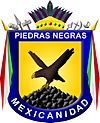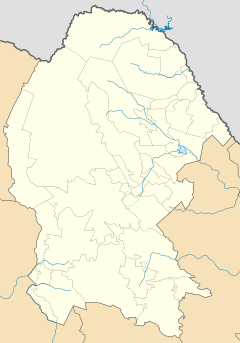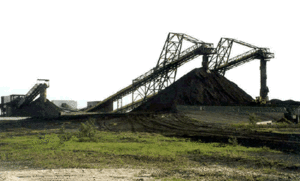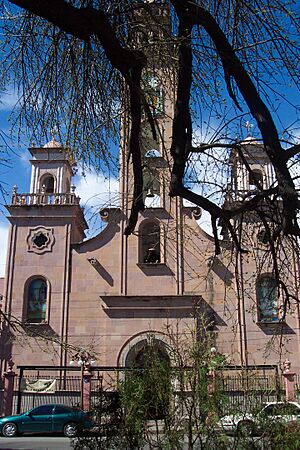Piedras Negras, Coahuila facts for kids
Quick facts for kids
Piedras Negras, Coahuila
|
||
|---|---|---|

Church of Our Lady of Guadalupe
|
||
|
||
| Nickname(s):
The Safe Border!
|
||
| Country | Mexico | |
| State | Coahuila | |
| Municipality | Piedras Negras | |
| Established | June 15, 1850 | |
| Area | ||
| • City | 914.2 km2 (353.0 sq mi) | |
| Elevation | 223 m (732 ft) | |
| Population
(2020)
|
||
| • City | 173,959 | |
| • Metro | 245,155 | |
| Demonym(s) | Nigropetense | |
| Time zone | UTC-6 (Central (US Central)) | |
| • Summer (DST) | UTC-5 (Central) | |
| Postal code |
26000
|
|
| Area code(s) | 878 | |
| Airport | Piedras Negras Int. Airport | |
Piedras Negras (which means 'black stones' in Spanish) is a city in the Mexican state of Coahuila. It's located right on the border between Mexico and the United States. Across the Rio Grande river, you'll find Eagle Pass in the U.S. state of Texas.
In 2015, about 163,595 people lived in Piedras Negras. The larger area around the city had about 245,155 residents. Piedras Negras and Eagle Pass are connected by several bridges, including the Eagle Pass–Piedras Negras International Bridge and a railroad bridge. The city got its name from the large amounts of coal found in the area, which look like black stones.
Contents
History of Piedras Negras
How the City Started
Piedras Negras was founded on June 15, 1850. A group of 34 men, led by Andrés Zapata, Gaspar Salazar, and Antonio Ramírez, met with Colonel Juan Manuel Maldonado. They told him they had created a new crossing point on the Rio Grande. They first named it Nueva Villa de Herrera. Later, it became known as Villa de Piedras Negras.
Early Challenges
In 1855, the town faced a difficult time. A group of Texans came into the area. They were looking for people who had escaped from slavery and Native Americans. This group of Texans looted Piedras Negras before returning to Texas.
Growth and Name Changes
The city grew a lot after large amounts of coal were found nearby. A railroad track was started in 1881 and finished in 1883. This helped the local economy boom. Because of this growth, Piedras Negras officially became a city on December 1, 1888. At that time, its name was changed to Ciudad Porfirio Díaz. However, after President Porfirio Díaz left power in 1911, the city's name went back to Piedras Negras, Coahuila.
Recent Events
Piedras Negras has faced some natural disasters:
- On April 26, 2004, a flood caused by the Río Escondido killed 31 people.
- On April 24, 2007, a very strong tornado (an F4 tornado) hit the city. Three people died in Piedras Negras, and seven in Eagle Pass, Texas.
- From June 14–15, 2013, over 10,000 homes were damaged by another flood, and one person died.
In 2018, a sad event occurred. The former mayor of Piedras Negras, Fernando Purón, was killed. He was running for a political position in the upcoming election. This event caused the current mayor to pause her own campaign to focus on her duties.
Geography and People
Population Growth
The northern part of Coahuila state has about 300,000 people. In 2005, Piedras Negras had 143,915 residents. This was about 5.77% of Coahuila's total population. Many people move to Piedras Negras from other Mexican states or even other countries. This is because it's a border city, and many factories here export goods to the U.S. Also, some people hope to cross the border into the United States. Piedras Negras is growing quickly and is expected to become the third most populated city in Coahuila soon. Today, it has over 200,000 residents.
Climate and Weather
Piedras Negras has a hot, semi-dry climate. This means it's often very warm. In summer, temperatures can go above 45 degrees Celsius (113 degrees Fahrenheit). The hottest months are from May to September. During this time, the average daily temperature is between 26 and 31 degrees Celsius (79 and 88 degrees Fahrenheit).
Piedras Negras is known as one of the hottest cities in Mexico. Most of the rain falls in May, June, and September. However, rain can be very unpredictable, sometimes leading to dry conditions. The driest months are from December to March.
| Climate data for Piedras Negras, Coahuila (1951–2010) | |||||||||||||
|---|---|---|---|---|---|---|---|---|---|---|---|---|---|
| Month | Jan | Feb | Mar | Apr | May | Jun | Jul | Aug | Sep | Oct | Nov | Dec | Year |
| Record high °C (°F) | 37.5 (99.5) |
40.2 (104.4) |
40.4 (104.7) |
42.4 (108.3) |
45.0 (113.0) |
48.6 (119.5) |
47.0 (116.6) |
45.4 (113.7) |
46.5 (115.7) |
39.4 (102.9) |
35.4 (95.7) |
34.5 (94.1) |
48.6 (119.5) |
| Mean daily maximum °C (°F) | 19.6 (67.3) |
22.0 (71.6) |
26.2 (79.2) |
30.7 (87.3) |
34.3 (93.7) |
37.3 (99.1) |
38.2 (100.8) |
38.4 (101.1) |
35.5 (95.9) |
29.8 (85.6) |
23.5 (74.3) |
20.2 (68.4) |
29.6 (85.3) |
| Daily mean °C (°F) | 12.2 (54.0) |
14.7 (58.5) |
18.6 (65.5) |
22.9 (73.2) |
27.2 (81.0) |
30.1 (86.2) |
31.0 (87.8) |
31.2 (88.2) |
28.4 (83.1) |
22.8 (73.0) |
16.5 (61.7) |
12.8 (55.0) |
22.4 (72.3) |
| Mean daily minimum °C (°F) | 4.9 (40.8) |
7.3 (45.1) |
11.1 (52.0) |
15.0 (59.0) |
20.0 (68.0) |
22.9 (73.2) |
23.8 (74.8) |
24.1 (75.4) |
21.3 (70.3) |
15.7 (60.3) |
9.5 (49.1) |
5.3 (41.5) |
15.1 (59.2) |
| Record low °C (°F) | −10.0 (14.0) |
−9.0 (15.8) |
−7.0 (19.4) |
−1.0 (30.2) |
2.4 (36.3) |
8.0 (46.4) |
12.0 (53.6) |
15.5 (59.9) |
9.0 (48.2) |
−3.0 (26.6) |
−7.0 (19.4) |
−8.0 (17.6) |
−10.0 (14.0) |
| Average precipitation mm (inches) | 19.1 (0.75) |
16.7 (0.66) |
27.5 (1.08) |
49.6 (1.95) |
69.6 (2.74) |
56.0 (2.20) |
59.3 (2.33) |
52.6 (2.07) |
73.2 (2.88) |
75.2 (2.96) |
25.9 (1.02) |
13.4 (0.53) |
538.1 (21.19) |
| Average precipitation days (≥ 0.1 mm) | 5.2 | 5.3 | 4.2 | 4.5 | 5.5 | 4.0 | 4.2 | 4.2 | 4.9 | 6.0 | 4.4 | 3.7 | 56.1 |
| Average relative humidity (%) | 70 | 67 | 62 | 65 | 67 | 67 | 60 | 60 | 66 | 68 | 70 | 69 | 66 |
| Mean monthly sunshine hours | 150 | 182 | 199 | 234 | 298 | 243 | 285 | 267 | 289 | 276 | 165 | 143 | 2,731 |
| Source 1: Servicio Meteorologico Nacional | |||||||||||||
| Source 2: Deutscher Wetterdienst (sun, 1961–1990) | |||||||||||||
Natural Resources
This region is very important for Mexico's coal production. Coal is a valuable mineral found here.
Piedras Negras in Pop Culture
Piedras Negras has been featured in music, television, and films:
- 1980: Song “Mi Piedras Negras" by Frankie y los Matadores.
- 1992: Song “Safe Side" by James McMurtry.
- 1993: The movie Like Water for Chocolate.
- 2007: The movie No Country for Old Men had scenes filmed in Piedras Negras.
- 2016: The TV show From Dusk Till Dawn (season 3).
Things to See and Do
Piedras Negras has many interesting places to visit:
- The Macro Plaza: This is a huge town square with restaurants, shops, and other businesses around it.
- San Bernardo Mission Ruins: You can explore the remains of an 18th-century mission.
- The Handicrafts Museum: Learn about local crafts and art.
- The Culture House: A place for cultural events and learning.
- Mercado Zaragoza: Also called El Mercado (the Market), this is a traditional Mexican market. You can find handmade arts, crafts, and traditional Mexican candies here.
- El Santuario de Nuestra Señora de Guadalupe: This church was built in 1859. It has survived battles and an explosion, showing its strength and history.
- Plaza de las Culturas: This park, built in 2005, honors Mexico's three main ancient cultures: Aztec, Mayan, and Olmec. It has replicas of pyramids from each culture, including a large one like the Pyramid of the Sun.
Transportation
If you want to fly to Piedras Negras, you can use the Aeropuerto Internacional de Piedras Negras.
Fun Local Events
International Day of the Nacho
Did you know nachos were invented in Piedras Negras? The International Day of the Nacho is celebrated every October 21. A three-day Nacho Fest also takes place. These events started in the 1990s to remember Ignacio "Nacho" Anaya, who created nachos in 1943 at the Victory Club restaurant in Piedras Negras.
Bike Fest
Every year, the Annual Bike Fest brings together motorcycle fans from Mexico and the U.S. It lasts for 2–3 days and includes concerts, food, acrobatic shows, and a motorcycle parade through town. There's even a drawing where someone can win a brand new motorcycle, like a Harley Davidson Sportster. This event helps the local economy a lot.
Local Media
Newspapers
- Zócalo News
- Periódico La Voz
- El Día News
Radio Stations
- EXA FM 105.5
- Di-94.5 FM Dinámica Auditiva
- Súper Estelar 107.9 FM
- Amor 107 FM
- La Rancherita del Aire 580 AM XEMU
Local Television
- Televisa Piedras Negras (XHPN)
- TV Azteca Piedras Negras
- Super Channel 12.1/12.2
Economy and Jobs
Piedras Negras is an important economic center in Coahuila. Most people work in factories or service jobs. Very few work in farming. The city has many factories, especially those that make car parts, electronic parts, and textiles. These factories employ almost 10,000 people.
Power Plants
- José López Portillo Thermoelectric Power Plant: This large power plant creates electricity using coal. It can produce 1200 megawatts of power. It's located near Piedras Negras and is a major landmark. The plant hires many people from the local area.
- Coal Thermoelectric Power Plant II: Also located nearby, this is another huge coal-fired power plant. It's the largest of its kind in Latin America, producing 1,400,000 kilowatts of power.
Manufacturing Companies
- Hendrickson Spring Mexico: This company makes springs for large trucks.
- SANLUIS Rassini: This company produces springs and other parts for car suspensions. Most of their products are sold in the U.S.
Other important employers include the coal mines and the Coca-Cola plant, which are located in the nearby municipality of Nava.
Industrial Parks
Piedras Negras has six industrial parks. These parks offer important services like water, electricity, and phone lines for businesses.
- Rio Grande Industrial Park
- Piedras Negras Industrial Park
- Friendship Piedras Negras I and II Industrial Park
- Santo Domingo Industrial Park
- Airport Business Industrial Park
- Northern Industrial Park
To encourage new companies to set up in Piedras Negras, the city offers special benefits. For example, new companies might not have to pay property taxes for three years.
Workforce and Salaries
The workers in Piedras Negras are skilled in making things for cars, textiles, and electronics. Many workers belong to labor unions. In 2006, a general worker earned about $47.85 to $87.60 per day.
Sister Cities
Piedras Negras has special partnerships with other cities:
- Sandy, Utah, United States
- Monterrey, Mexico
Images for kids
See also
 In Spanish: Piedras Negras para niños
In Spanish: Piedras Negras para niños










